Exploring Developmental Psychology of Infants' Cognitive Growth
VerifiedAdded on 2022/05/02
|9
|2010
|24
Essay
AI Summary
This essay delves into the developmental psychology of infants, exploring key concepts and research findings. It begins with an introduction to developmental psychology, discussing the physical, social, cognitive, and emotional changes that occur in infants. The essay highlights key developments in infants' understanding, including early learning and the holistic concept of healthy child development. It emphasizes the importance of observation in understanding infant behavior and explores various theories and evidence related to infants' perception and cognition. The essay also addresses current controversies in the field, such as infants' numerical abilities. The essay concludes by summarizing the key points and acknowledging the role of both nature and nurture in infant development. Relevant references are provided to support the discussed concepts.
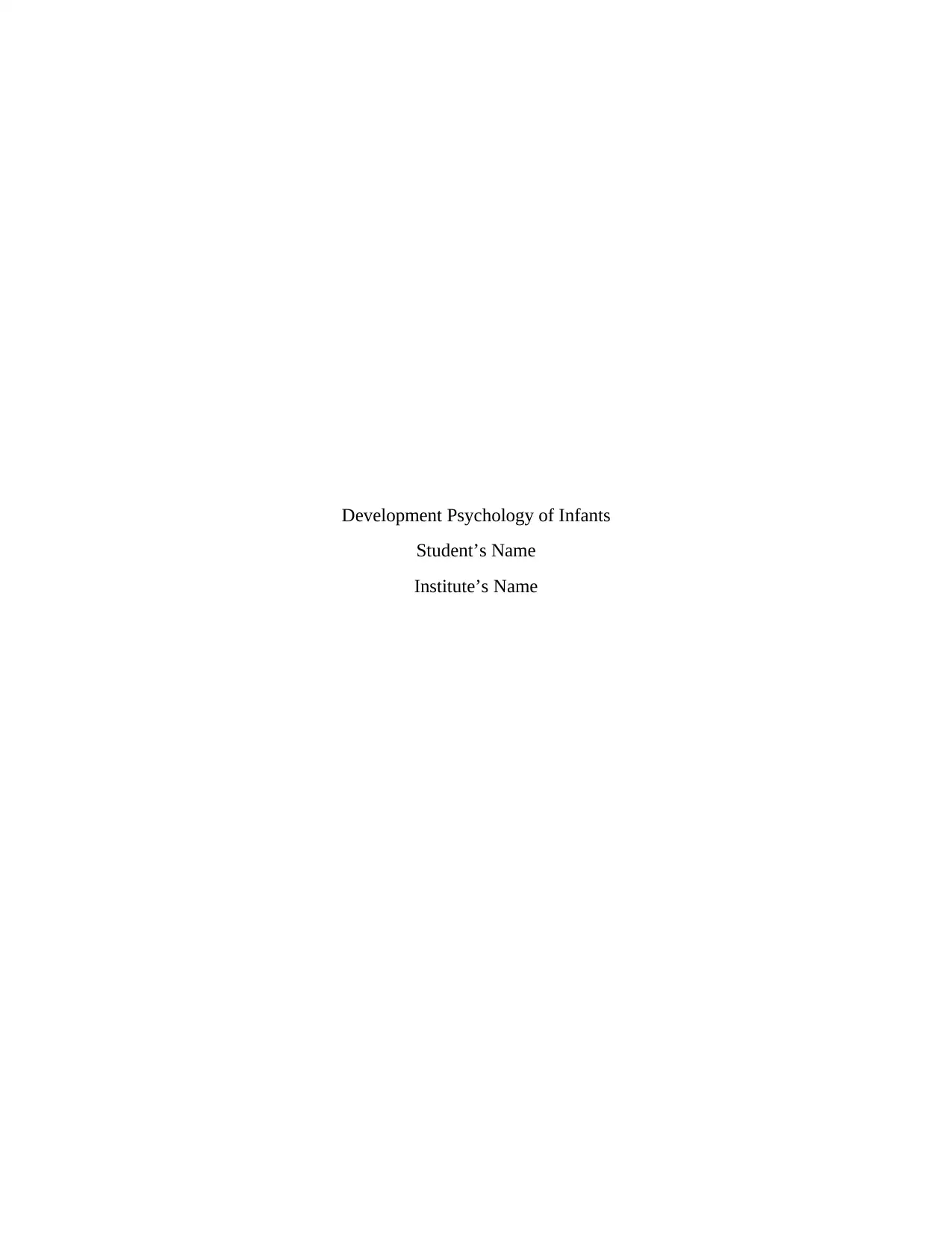
Development Psychology of Infants
Student’s Name
Institute’s Name
Student’s Name
Institute’s Name
Paraphrase This Document
Need a fresh take? Get an instant paraphrase of this document with our AI Paraphraser
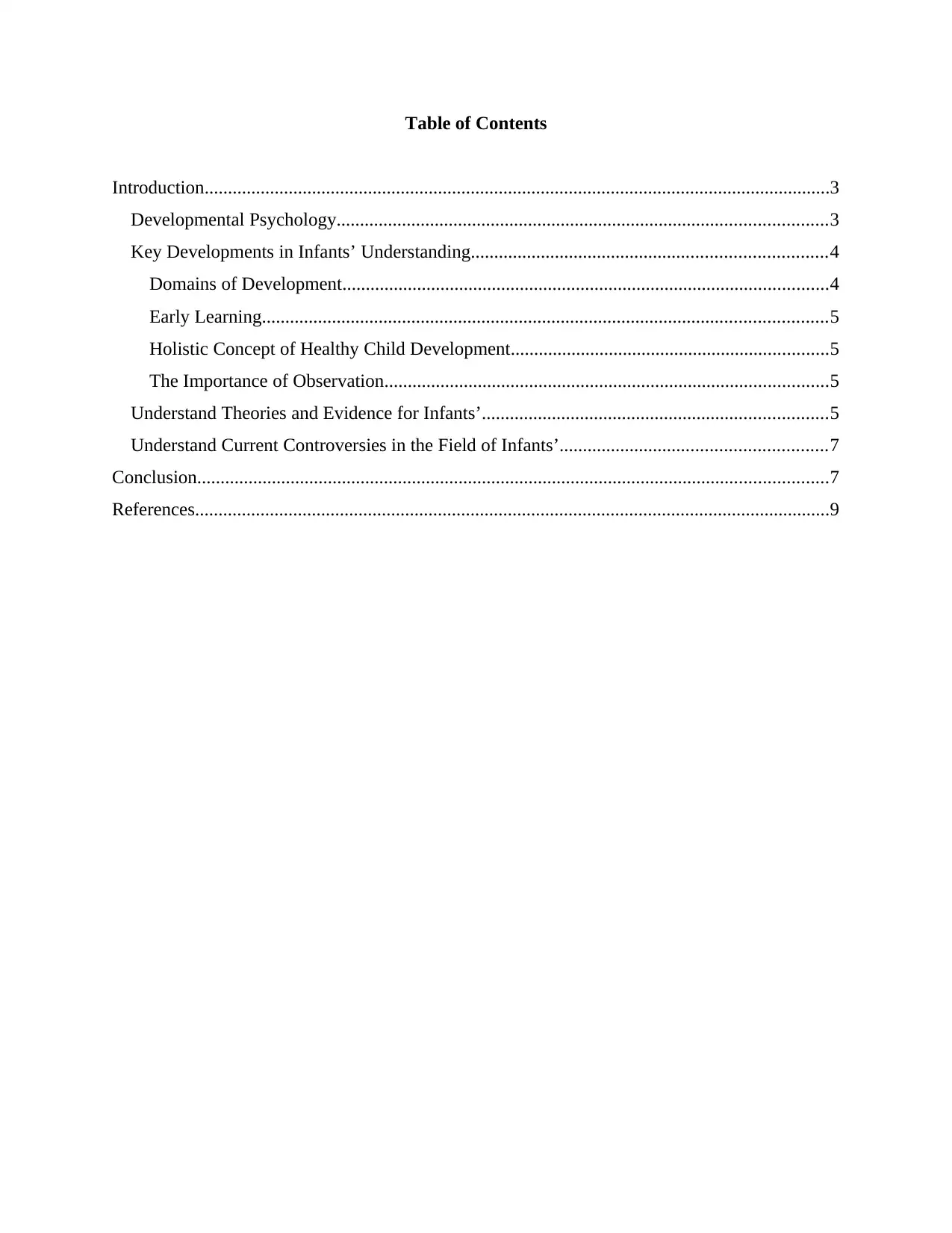
Table of Contents
Introduction......................................................................................................................................3
Developmental Psychology.........................................................................................................3
Key Developments in Infants’ Understanding............................................................................4
Domains of Development........................................................................................................4
Early Learning.........................................................................................................................5
Holistic Concept of Healthy Child Development....................................................................5
The Importance of Observation...............................................................................................5
Understand Theories and Evidence for Infants’..........................................................................5
Understand Current Controversies in the Field of Infants’.........................................................7
Conclusion.......................................................................................................................................7
References........................................................................................................................................9
Introduction......................................................................................................................................3
Developmental Psychology.........................................................................................................3
Key Developments in Infants’ Understanding............................................................................4
Domains of Development........................................................................................................4
Early Learning.........................................................................................................................5
Holistic Concept of Healthy Child Development....................................................................5
The Importance of Observation...............................................................................................5
Understand Theories and Evidence for Infants’..........................................................................5
Understand Current Controversies in the Field of Infants’.........................................................7
Conclusion.......................................................................................................................................7
References........................................................................................................................................9
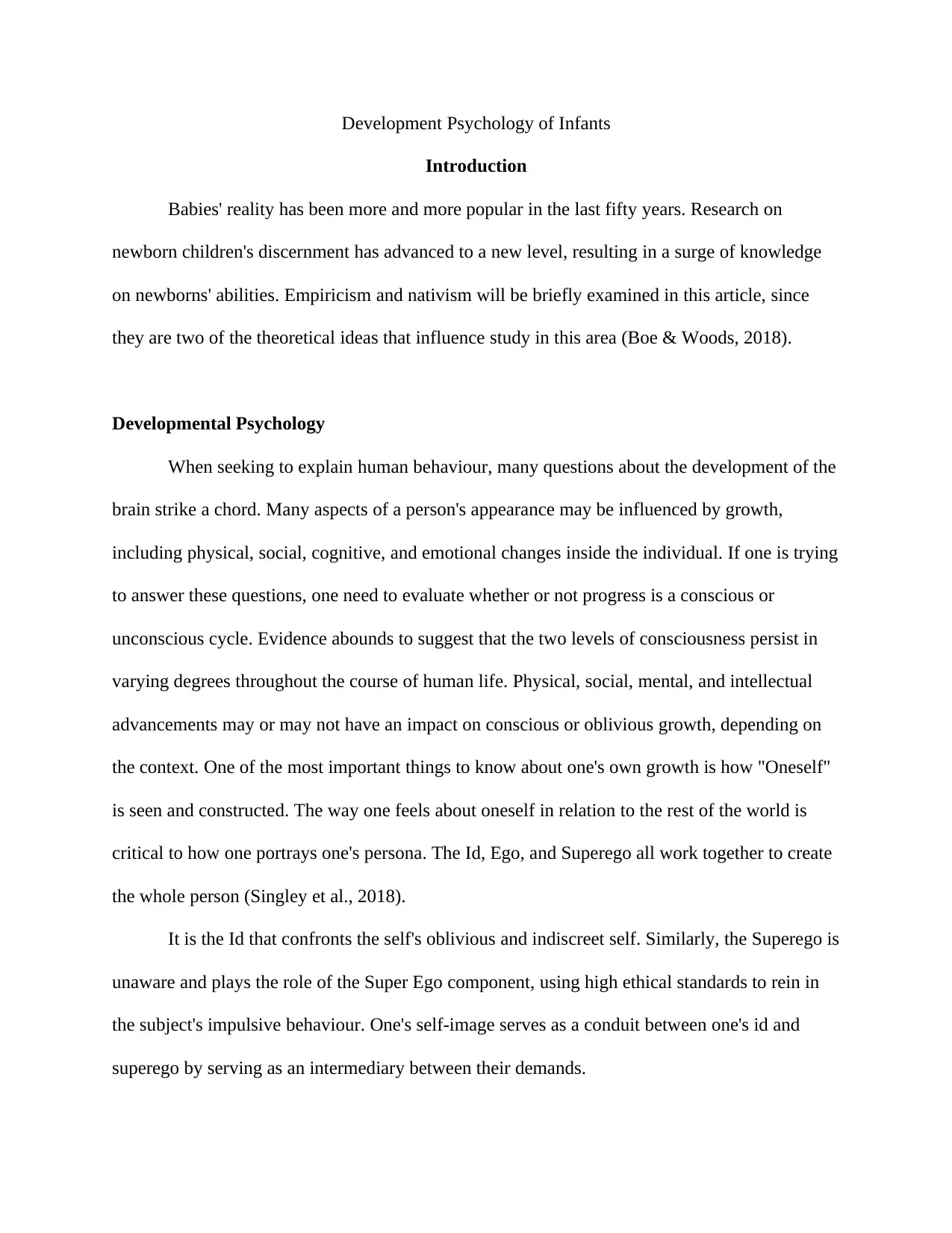
Development Psychology of Infants
Introduction
Babies' reality has been more and more popular in the last fifty years. Research on
newborn children's discernment has advanced to a new level, resulting in a surge of knowledge
on newborns' abilities. Empiricism and nativism will be briefly examined in this article, since
they are two of the theoretical ideas that influence study in this area (Boe & Woods, 2018).
Developmental Psychology
When seeking to explain human behaviour, many questions about the development of the
brain strike a chord. Many aspects of a person's appearance may be influenced by growth,
including physical, social, cognitive, and emotional changes inside the individual. If one is trying
to answer these questions, one need to evaluate whether or not progress is a conscious or
unconscious cycle. Evidence abounds to suggest that the two levels of consciousness persist in
varying degrees throughout the course of human life. Physical, social, mental, and intellectual
advancements may or may not have an impact on conscious or oblivious growth, depending on
the context. One of the most important things to know about one's own growth is how "Oneself"
is seen and constructed. The way one feels about oneself in relation to the rest of the world is
critical to how one portrays one's persona. The Id, Ego, and Superego all work together to create
the whole person (Singley et al., 2018).
It is the Id that confronts the self's oblivious and indiscreet self. Similarly, the Superego is
unaware and plays the role of the Super Ego component, using high ethical standards to rein in
the subject's impulsive behaviour. One's self-image serves as a conduit between one's id and
superego by serving as an intermediary between their demands.
Introduction
Babies' reality has been more and more popular in the last fifty years. Research on
newborn children's discernment has advanced to a new level, resulting in a surge of knowledge
on newborns' abilities. Empiricism and nativism will be briefly examined in this article, since
they are two of the theoretical ideas that influence study in this area (Boe & Woods, 2018).
Developmental Psychology
When seeking to explain human behaviour, many questions about the development of the
brain strike a chord. Many aspects of a person's appearance may be influenced by growth,
including physical, social, cognitive, and emotional changes inside the individual. If one is trying
to answer these questions, one need to evaluate whether or not progress is a conscious or
unconscious cycle. Evidence abounds to suggest that the two levels of consciousness persist in
varying degrees throughout the course of human life. Physical, social, mental, and intellectual
advancements may or may not have an impact on conscious or oblivious growth, depending on
the context. One of the most important things to know about one's own growth is how "Oneself"
is seen and constructed. The way one feels about oneself in relation to the rest of the world is
critical to how one portrays one's persona. The Id, Ego, and Superego all work together to create
the whole person (Singley et al., 2018).
It is the Id that confronts the self's oblivious and indiscreet self. Similarly, the Superego is
unaware and plays the role of the Super Ego component, using high ethical standards to rein in
the subject's impulsive behaviour. One's self-image serves as a conduit between one's id and
superego by serving as an intermediary between their demands.
⊘ This is a preview!⊘
Do you want full access?
Subscribe today to unlock all pages.

Trusted by 1+ million students worldwide
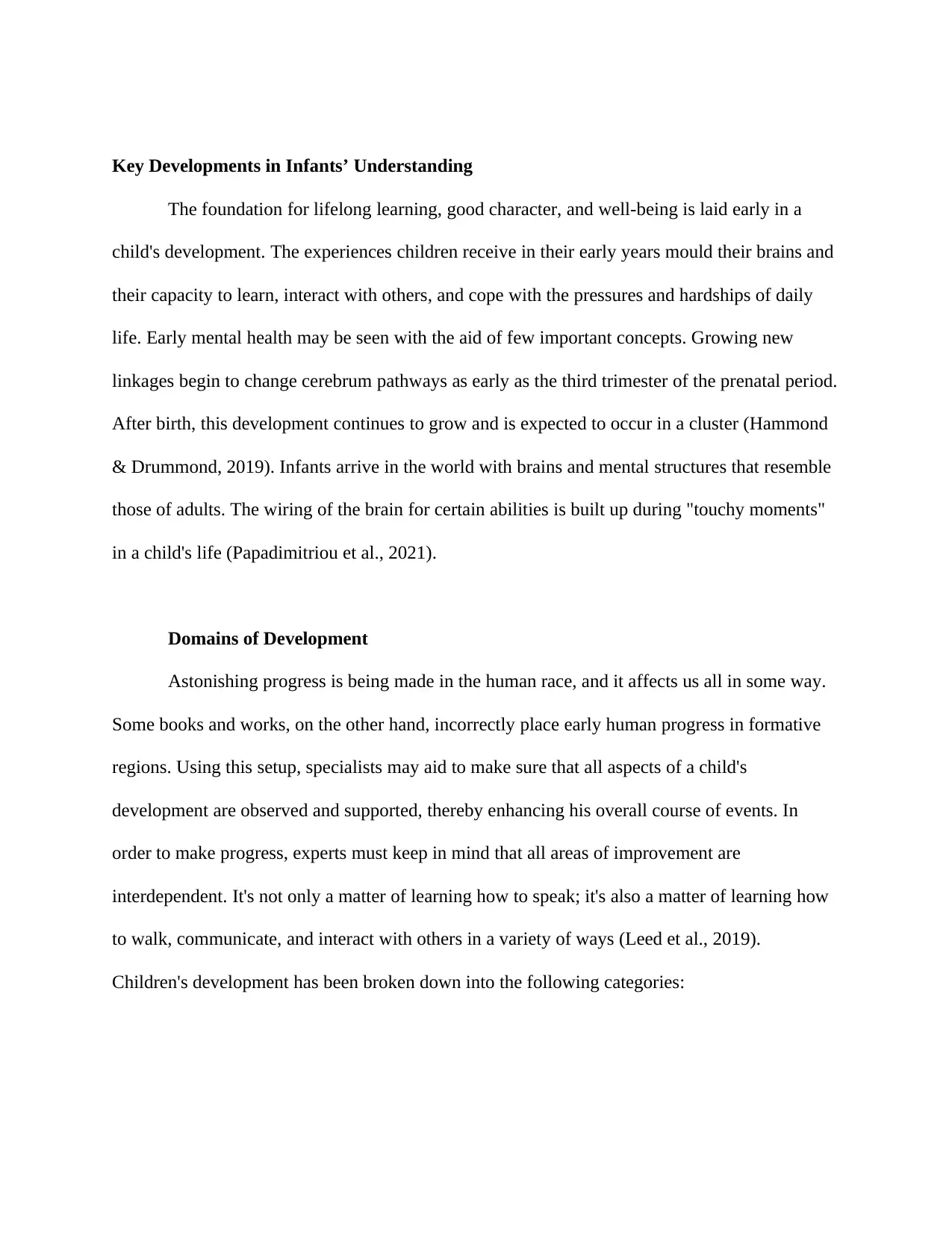
Key Developments in Infants’ Understanding
The foundation for lifelong learning, good character, and well-being is laid early in a
child's development. The experiences children receive in their early years mould their brains and
their capacity to learn, interact with others, and cope with the pressures and hardships of daily
life. Early mental health may be seen with the aid of few important concepts. Growing new
linkages begin to change cerebrum pathways as early as the third trimester of the prenatal period.
After birth, this development continues to grow and is expected to occur in a cluster (Hammond
& Drummond, 2019). Infants arrive in the world with brains and mental structures that resemble
those of adults. The wiring of the brain for certain abilities is built up during "touchy moments"
in a child's life (Papadimitriou et al., 2021).
Domains of Development
Astonishing progress is being made in the human race, and it affects us all in some way.
Some books and works, on the other hand, incorrectly place early human progress in formative
regions. Using this setup, specialists may aid to make sure that all aspects of a child's
development are observed and supported, thereby enhancing his overall course of events. In
order to make progress, experts must keep in mind that all areas of improvement are
interdependent. It's not only a matter of learning how to speak; it's also a matter of learning how
to walk, communicate, and interact with others in a variety of ways (Leed et al., 2019).
Children's development has been broken down into the following categories:
The foundation for lifelong learning, good character, and well-being is laid early in a
child's development. The experiences children receive in their early years mould their brains and
their capacity to learn, interact with others, and cope with the pressures and hardships of daily
life. Early mental health may be seen with the aid of few important concepts. Growing new
linkages begin to change cerebrum pathways as early as the third trimester of the prenatal period.
After birth, this development continues to grow and is expected to occur in a cluster (Hammond
& Drummond, 2019). Infants arrive in the world with brains and mental structures that resemble
those of adults. The wiring of the brain for certain abilities is built up during "touchy moments"
in a child's life (Papadimitriou et al., 2021).
Domains of Development
Astonishing progress is being made in the human race, and it affects us all in some way.
Some books and works, on the other hand, incorrectly place early human progress in formative
regions. Using this setup, specialists may aid to make sure that all aspects of a child's
development are observed and supported, thereby enhancing his overall course of events. In
order to make progress, experts must keep in mind that all areas of improvement are
interdependent. It's not only a matter of learning how to speak; it's also a matter of learning how
to walk, communicate, and interact with others in a variety of ways (Leed et al., 2019).
Children's development has been broken down into the following categories:
Paraphrase This Document
Need a fresh take? Get an instant paraphrase of this document with our AI Paraphraser
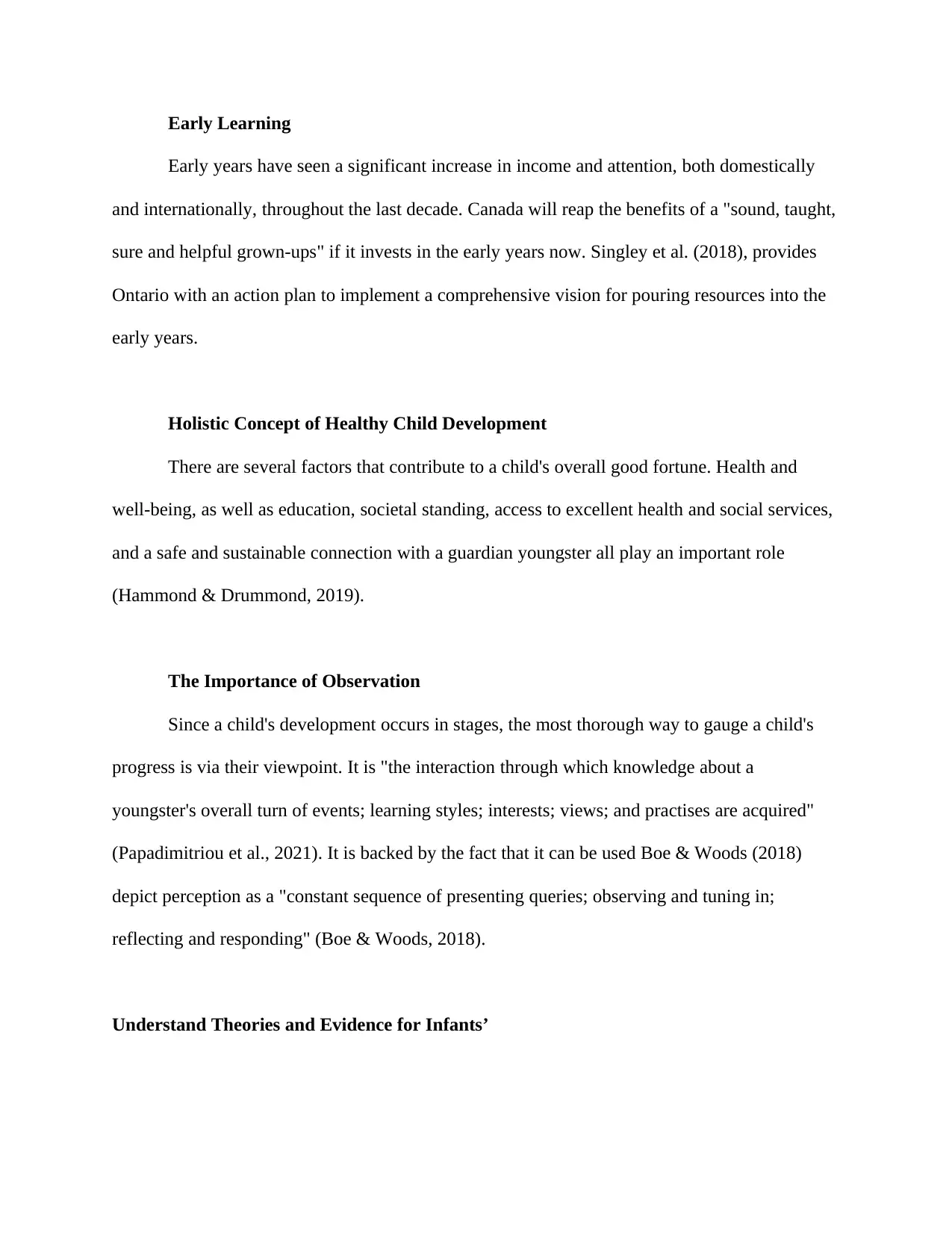
Early Learning
Early years have seen a significant increase in income and attention, both domestically
and internationally, throughout the last decade. Canada will reap the benefits of a "sound, taught,
sure and helpful grown-ups" if it invests in the early years now. Singley et al. (2018), provides
Ontario with an action plan to implement a comprehensive vision for pouring resources into the
early years.
Holistic Concept of Healthy Child Development
There are several factors that contribute to a child's overall good fortune. Health and
well-being, as well as education, societal standing, access to excellent health and social services,
and a safe and sustainable connection with a guardian youngster all play an important role
(Hammond & Drummond, 2019).
The Importance of Observation
Since a child's development occurs in stages, the most thorough way to gauge a child's
progress is via their viewpoint. It is "the interaction through which knowledge about a
youngster's overall turn of events; learning styles; interests; views; and practises are acquired"
(Papadimitriou et al., 2021). It is backed by the fact that it can be used Boe & Woods (2018)
depict perception as a "constant sequence of presenting queries; observing and tuning in;
reflecting and responding" (Boe & Woods, 2018).
Understand Theories and Evidence for Infants’
Early years have seen a significant increase in income and attention, both domestically
and internationally, throughout the last decade. Canada will reap the benefits of a "sound, taught,
sure and helpful grown-ups" if it invests in the early years now. Singley et al. (2018), provides
Ontario with an action plan to implement a comprehensive vision for pouring resources into the
early years.
Holistic Concept of Healthy Child Development
There are several factors that contribute to a child's overall good fortune. Health and
well-being, as well as education, societal standing, access to excellent health and social services,
and a safe and sustainable connection with a guardian youngster all play an important role
(Hammond & Drummond, 2019).
The Importance of Observation
Since a child's development occurs in stages, the most thorough way to gauge a child's
progress is via their viewpoint. It is "the interaction through which knowledge about a
youngster's overall turn of events; learning styles; interests; views; and practises are acquired"
(Papadimitriou et al., 2021). It is backed by the fact that it can be used Boe & Woods (2018)
depict perception as a "constant sequence of presenting queries; observing and tuning in;
reflecting and responding" (Boe & Woods, 2018).
Understand Theories and Evidence for Infants’
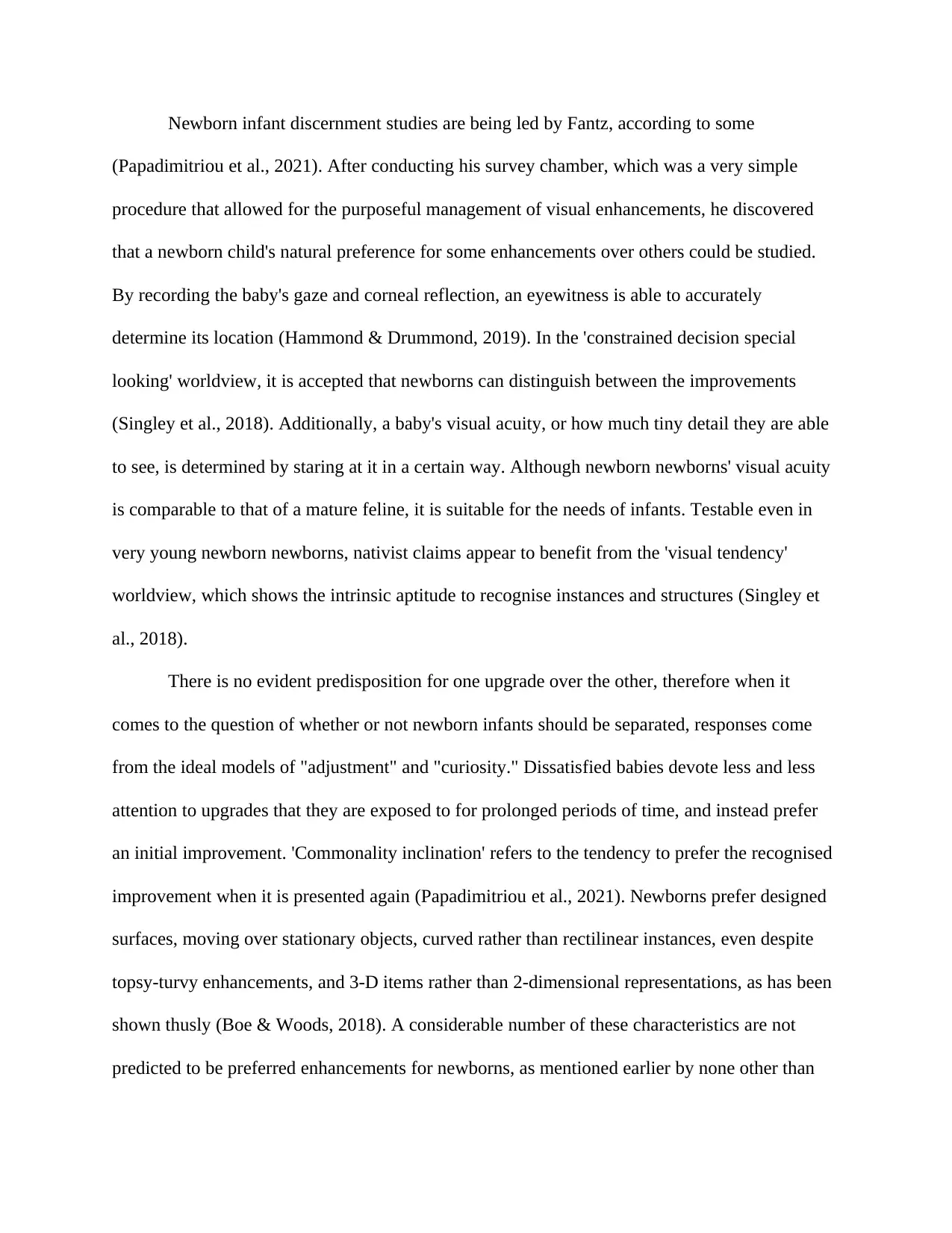
Newborn infant discernment studies are being led by Fantz, according to some
(Papadimitriou et al., 2021). After conducting his survey chamber, which was a very simple
procedure that allowed for the purposeful management of visual enhancements, he discovered
that a newborn child's natural preference for some enhancements over others could be studied.
By recording the baby's gaze and corneal reflection, an eyewitness is able to accurately
determine its location (Hammond & Drummond, 2019). In the 'constrained decision special
looking' worldview, it is accepted that newborns can distinguish between the improvements
(Singley et al., 2018). Additionally, a baby's visual acuity, or how much tiny detail they are able
to see, is determined by staring at it in a certain way. Although newborn newborns' visual acuity
is comparable to that of a mature feline, it is suitable for the needs of infants. Testable even in
very young newborn newborns, nativist claims appear to benefit from the 'visual tendency'
worldview, which shows the intrinsic aptitude to recognise instances and structures (Singley et
al., 2018).
There is no evident predisposition for one upgrade over the other, therefore when it
comes to the question of whether or not newborn infants should be separated, responses come
from the ideal models of "adjustment" and "curiosity." Dissatisfied babies devote less and less
attention to upgrades that they are exposed to for prolonged periods of time, and instead prefer
an initial improvement. 'Commonality inclination' refers to the tendency to prefer the recognised
improvement when it is presented again (Papadimitriou et al., 2021). Newborns prefer designed
surfaces, moving over stationary objects, curved rather than rectilinear instances, even despite
topsy-turvy enhancements, and 3-D items rather than 2-dimensional representations, as has been
shown thusly (Boe & Woods, 2018). A considerable number of these characteristics are not
predicted to be preferred enhancements for newborns, as mentioned earlier by none other than
(Papadimitriou et al., 2021). After conducting his survey chamber, which was a very simple
procedure that allowed for the purposeful management of visual enhancements, he discovered
that a newborn child's natural preference for some enhancements over others could be studied.
By recording the baby's gaze and corneal reflection, an eyewitness is able to accurately
determine its location (Hammond & Drummond, 2019). In the 'constrained decision special
looking' worldview, it is accepted that newborns can distinguish between the improvements
(Singley et al., 2018). Additionally, a baby's visual acuity, or how much tiny detail they are able
to see, is determined by staring at it in a certain way. Although newborn newborns' visual acuity
is comparable to that of a mature feline, it is suitable for the needs of infants. Testable even in
very young newborn newborns, nativist claims appear to benefit from the 'visual tendency'
worldview, which shows the intrinsic aptitude to recognise instances and structures (Singley et
al., 2018).
There is no evident predisposition for one upgrade over the other, therefore when it
comes to the question of whether or not newborn infants should be separated, responses come
from the ideal models of "adjustment" and "curiosity." Dissatisfied babies devote less and less
attention to upgrades that they are exposed to for prolonged periods of time, and instead prefer
an initial improvement. 'Commonality inclination' refers to the tendency to prefer the recognised
improvement when it is presented again (Papadimitriou et al., 2021). Newborns prefer designed
surfaces, moving over stationary objects, curved rather than rectilinear instances, even despite
topsy-turvy enhancements, and 3-D items rather than 2-dimensional representations, as has been
shown thusly (Boe & Woods, 2018). A considerable number of these characteristics are not
predicted to be preferred enhancements for newborns, as mentioned earlier by none other than
⊘ This is a preview!⊘
Do you want full access?
Subscribe today to unlock all pages.

Trusted by 1+ million students worldwide
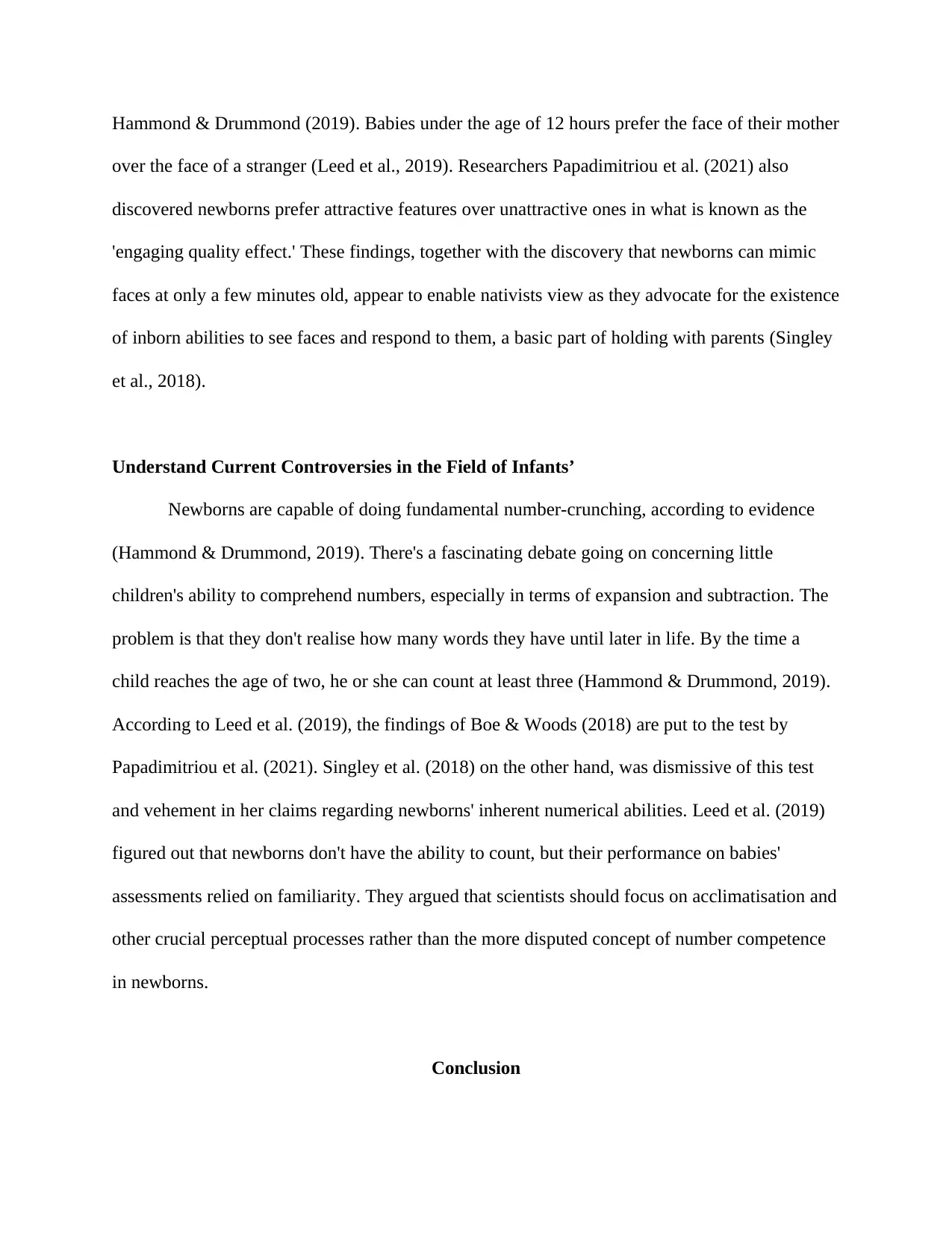
Hammond & Drummond (2019). Babies under the age of 12 hours prefer the face of their mother
over the face of a stranger (Leed et al., 2019). Researchers Papadimitriou et al. (2021) also
discovered newborns prefer attractive features over unattractive ones in what is known as the
'engaging quality effect.' These findings, together with the discovery that newborns can mimic
faces at only a few minutes old, appear to enable nativists view as they advocate for the existence
of inborn abilities to see faces and respond to them, a basic part of holding with parents (Singley
et al., 2018).
Understand Current Controversies in the Field of Infants’
Newborns are capable of doing fundamental number-crunching, according to evidence
(Hammond & Drummond, 2019). There's a fascinating debate going on concerning little
children's ability to comprehend numbers, especially in terms of expansion and subtraction. The
problem is that they don't realise how many words they have until later in life. By the time a
child reaches the age of two, he or she can count at least three (Hammond & Drummond, 2019).
According to Leed et al. (2019), the findings of Boe & Woods (2018) are put to the test by
Papadimitriou et al. (2021). Singley et al. (2018) on the other hand, was dismissive of this test
and vehement in her claims regarding newborns' inherent numerical abilities. Leed et al. (2019)
figured out that newborns don't have the ability to count, but their performance on babies'
assessments relied on familiarity. They argued that scientists should focus on acclimatisation and
other crucial perceptual processes rather than the more disputed concept of number competence
in newborns.
Conclusion
over the face of a stranger (Leed et al., 2019). Researchers Papadimitriou et al. (2021) also
discovered newborns prefer attractive features over unattractive ones in what is known as the
'engaging quality effect.' These findings, together with the discovery that newborns can mimic
faces at only a few minutes old, appear to enable nativists view as they advocate for the existence
of inborn abilities to see faces and respond to them, a basic part of holding with parents (Singley
et al., 2018).
Understand Current Controversies in the Field of Infants’
Newborns are capable of doing fundamental number-crunching, according to evidence
(Hammond & Drummond, 2019). There's a fascinating debate going on concerning little
children's ability to comprehend numbers, especially in terms of expansion and subtraction. The
problem is that they don't realise how many words they have until later in life. By the time a
child reaches the age of two, he or she can count at least three (Hammond & Drummond, 2019).
According to Leed et al. (2019), the findings of Boe & Woods (2018) are put to the test by
Papadimitriou et al. (2021). Singley et al. (2018) on the other hand, was dismissive of this test
and vehement in her claims regarding newborns' inherent numerical abilities. Leed et al. (2019)
figured out that newborns don't have the ability to count, but their performance on babies'
assessments relied on familiarity. They argued that scientists should focus on acclimatisation and
other crucial perceptual processes rather than the more disputed concept of number competence
in newborns.
Conclusion
Paraphrase This Document
Need a fresh take? Get an instant paraphrase of this document with our AI Paraphraser

Perceptual frameworks of infants are, in all likelihood, immature despite evidence of
prenatal hearing, yet the hearing-capable bodily constructs and ability are undoubtedly more
advanced upon arrival in the world than the visual framework. For the most part, researchers rely
on social cues, such as a baby's expression, head tilt, or sucking, to draw inferences about their
thinking abilities. It has recently been shown that newborn children's perceptual capabilities are
not only equipped with particular mechanisms for learning about their environment, but also that
experience plays an important role in the development of these abilities. Then, nature and
preservation are linked.
prenatal hearing, yet the hearing-capable bodily constructs and ability are undoubtedly more
advanced upon arrival in the world than the visual framework. For the most part, researchers rely
on social cues, such as a baby's expression, head tilt, or sucking, to draw inferences about their
thinking abilities. It has recently been shown that newborn children's perceptual capabilities are
not only equipped with particular mechanisms for learning about their environment, but also that
experience plays an important role in the development of these abilities. Then, nature and
preservation are linked.

References
Boe, J. L., & Woods, R. J. (2018). Parents’ influence on infants’ gender-typed toy preferences.
Sex Roles, 79(5), 358–373.
Hammond, S. I., & Drummond, J. K. (2019). Rethinking emotions in the context of infants’
prosocial behavior: The role of interest and positive emotions. Developmental
Psychology, 55(9), 1882.
Leed, J. E., Chinn, L. K., & Lockman, J. J. (2019). Reaching to the self: The development of
infants’ ability to localize targets on the body. Psychological Science, 30(7), 1063–1073.
Papadimitriou, A., Smyth, C., Politimou, N., Franco, F., & Stewart, L. (2021). The impact of the
home musical environment on infants’ language development. Infant Behavior and
Development, 65, 101651.
Singley, D. B., Cole, B. P., Hammer, J. H., Molloy, S., Rowell, A., & Isacco, A. (2018).
Development and psychometric evaluation of the Paternal Involvement With Infants
Scale. Psychology of Men & Masculinity, 19(2), 167.
Boe, J. L., & Woods, R. J. (2018). Parents’ influence on infants’ gender-typed toy preferences.
Sex Roles, 79(5), 358–373.
Hammond, S. I., & Drummond, J. K. (2019). Rethinking emotions in the context of infants’
prosocial behavior: The role of interest and positive emotions. Developmental
Psychology, 55(9), 1882.
Leed, J. E., Chinn, L. K., & Lockman, J. J. (2019). Reaching to the self: The development of
infants’ ability to localize targets on the body. Psychological Science, 30(7), 1063–1073.
Papadimitriou, A., Smyth, C., Politimou, N., Franco, F., & Stewart, L. (2021). The impact of the
home musical environment on infants’ language development. Infant Behavior and
Development, 65, 101651.
Singley, D. B., Cole, B. P., Hammer, J. H., Molloy, S., Rowell, A., & Isacco, A. (2018).
Development and psychometric evaluation of the Paternal Involvement With Infants
Scale. Psychology of Men & Masculinity, 19(2), 167.
⊘ This is a preview!⊘
Do you want full access?
Subscribe today to unlock all pages.

Trusted by 1+ million students worldwide
1 out of 9
Related Documents
Your All-in-One AI-Powered Toolkit for Academic Success.
+13062052269
info@desklib.com
Available 24*7 on WhatsApp / Email
![[object Object]](/_next/static/media/star-bottom.7253800d.svg)
Unlock your academic potential
Copyright © 2020–2025 A2Z Services. All Rights Reserved. Developed and managed by ZUCOL.





